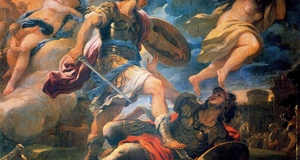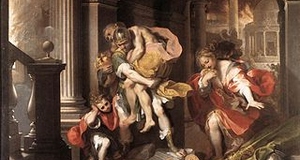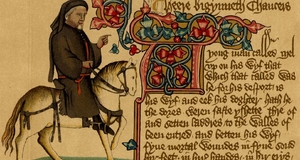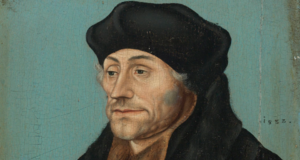Exploring Virgilian Structures in Book III of Spenser's Faerie Queene
By
2014, Vol. 6 No. 04 | pg. 1/2 | »
IN THIS ARTICLE
KEYWORDS
Contrary to the scintillating promise of its title, Spenser’s Faerie Queene is a far cry from the insubstantial delights of light fantasy fiction. A narrative poem in six books, this hefty labyrinthine work chronicles the quests of the patron knights of six virtues through their perpetual stumblings and successes. Initially upon beholding its very physical bulk as it lies ponderously on the table, one might be excused for believing that there cannot possibly exist syntactic parallels with other works within individual lines of this work. The discovery that Spenser indeed seems to have woven these subtleties into his poetry makes the reader’s navigation through this labyrinth even more wonderful. Book III of the Faerie Queene chronicles the journey of Britomart, the female patron knight of chastity, as she searches for her true love, Artegall, with whom she is destined to establish the race of the Britons. Merlin’s Prophecy: England as Rome’s SuccessorIn Book III of the Faerie Queene, Britomart declares that Britain “in all glory and great enterprise/Both first and second Troy shall dare to equalise” (canto ix). In these lines, Spenser alludes to the late Trojan and Roman empires, using them as terms in a tricolon crescens which culminates in the British empire yet unborn. His prediction is charged with the electric force of nationalism. Situational parallels between Jupiter and Venus’ exchange in the Aeneid and Merlin and Britomart’s exchange of canto iii legitimize Britain’s imperial right by blood. By echoing several of Virgil’s epithets, Spenser places England foremost in the direct line of succession to imperial glory. 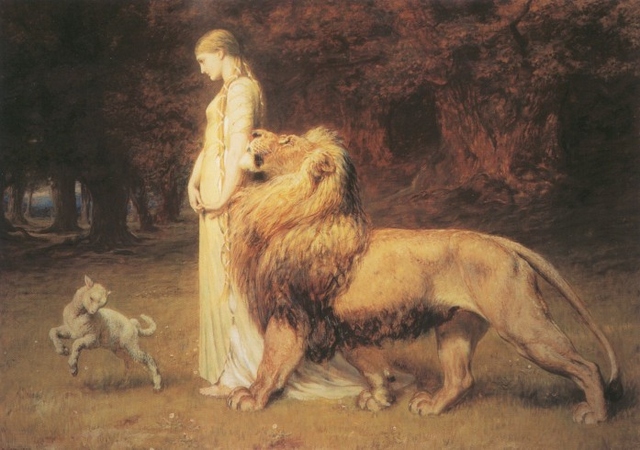
Una and Lion, by British painter Briton Riviere (1840-1920), depicts a scene from the Faerie Queene. While Merlin’s prophecy undoubtedly has the general aura of the epic about it, specific syntactical and situational parallels also abound between this scene and Jupiter’s prophecy of the future of the Roman race to Venus in the Aeneid. Merlin reveals to Britomart that a “famous Progenee/Shall spring, out of auncient Troian blood” from her womb (canto iii, l. 5-6), just as the Roman race was “Troiano a sanguine duci” (“led from Trojan blood”) according to Virgil’s Aeneid I.19-22. The early 16th century Douglas translation of Virgil’s Aeneid into Scottish, with which Spenser himself may have been familiar, translates this line, “Of Troiane blude a pepill suld discend” (“Of Trojan blood a people should descend,” 20, l. 19). The modern English Cranch translation of the Aeneid translates this line, “a race derived from Trojan blood” (2, l. 19). The core phrase common to Merlin’s dialogue and both translation from the Aeneid is “[out] of Trojan blood.” This syntactic parallel connects the Britons to the Romans and the Trojans by blood. This is a crucial link, as issues of legitimacy in 16th century British politics inevitably revolved around blood ties. As the daughter of Anne Boleyn, whose claims to the throne were tenuous at best in the eyes of much of the British public, Elizabeth I’s own legitimacy as heir to the throne was mired in controversy. Thus, legitimacy by blood was the most credible substantiation Spenser could use to assert that the British were the rightful heirs of Trojan and Roman imperial power. By asserting a blood tie between these three otherwise distinct cultures, Spenser rendered this claim indisputable. While Spenser is often critical of England and its government throughout the Faerie Queene, he endorses both in this particular line by stating his belief that England has the power to “equalise” both the Trojan and Roman empires. In many ways, canto iii is Spenser’s shrine to the age of Gloriana. Changeable as his opinion of English government may otherwise be, this particular episode is unblemished by any political reservations. As one of the only instances wherein Spenser yields to patriotic pride, it is a singularly rare and inspiring gem. It is somewhat ironic that Spenser should portray England as a unique chapter in the history of great empires while anchoring and relating it to previous empires. Tonkin makes a similar observation, stating that while “echoes of Virgil…abound [in the Faerie Queene]…it is a home-grown, English product” (52). Spenser strikes the balance between acknowledging England’s ties to previous empires for the sake of legitimacy and setting it apart from other empires by creating a unique history for it. For example, Tonkin observes that while Spenser “describes the origins and fulfillment of the English nation just as Virgil describes that of Rome…he does so through a mythology essentially his own” (25). Merlin’s prophecy contains a lengthy chronology of uniquely English historical figures, both real and fictional, including Vortipore, Cadwallin, Rhodoricke, and Uther, to name a few. Spenser’s discourse of English warrior kings who never existed is a rather elaborate fabrication – but it has a deeper purpose than mere fiction. It is a potent statement that although the Britons have sprung “out of auncient Troian blood,” their identity and heritage are uniquely their own. This is one of the major ways in which Spenser “accompanies prophecy with patriotism” (Freeman 191). Britomart and Venus: Opposite Sides of the Same CoinCanto iii of the Faerie Queene parallels an exchange between Jupiter and Venus in Book I of the Aeneid. Cheney addresses the syntactical aspect of this parallel, noting how Merlin eases Britomart’s fears about the future by reassuring her that “Indeede the fates are firme” (canto iii, s. 25, l. 6). Similarly, Jupiter reassures Venus that although the Trojans have recently been tossed by Aeolus’ fierce winds, “Aeneas’ wandering fate is firm,” according to Cheney’s translation. Cheney also states that this line (“manent immota tuorum”) is “one of the most famous lines in the Aeneid” (110). He italicizes the words fate and firm in both lines to emphasize the parallel in meaning and word choice between the two poems. The high degree of similarity in meaning and word choice, as well as the fame of this line in the Aeneid, suggest that this was a deliberate syntactical parallel on Spenser’s part. Knowing the depth and intricacy of the connections which Spenser habitually draws between ideas in the Faerie Queene, it would be practically counterintuitive to expect that the parallel phrasing of these two lines is the only similarity he expects his readers to notice. In truth, it is merely the tip of the iceberg. The syntactic parallels between these two lines are indicative of much deeper macroscopic similarities between the two scenes. Merlin and Jupiter play similar roles in the structure of each scene. Both are men to whom the fates’ design has been revealed, although neither one technically has control over the fates’ design. Nonetheless, both characters use their exclusive knowledge in an advisory capacity to reassure a maternal figure about the guaranteed success of her offspring. Jupiter’s prophecy is a chronology of Roman history extending to its golden age, when “Caesar from the Julian stock shall rise” (Clarke 12, l. 286). Merlin’s prophecy is also a chronology of English history, true and fictional, extending to the golden age during the reign of the “royall Virgin,” Elizabeth I (s. 49, l. 6). The epic grandeur of both of these prophecies is intended to strike awe into its listeners. Both were written to be deeply internalized – to stir wonder in those who were not members of the celestially-favored empires, and emblazon pride upon the hearts of those who were. However, perhaps the more interesting parallel is that between Britomart and Venus, both of whom are originators of peoples who undergo prolonged tribulations before rising to power. At the point when Venus seeks counsel from Jupiter, her son Aeneas has recently been “by various tempests [of Aeolus] tossed” (Clarke 10, l. 232). Similarly, Merlin foretells that the Britons shall be “broken with long warre [before] they shall upreare” and become a glorious race. Most prominently, both characters are patrons of love. This particular similarity between the two is noted by the Spenser Encyclopedia, which classifies Britomart as a “Venus armata” (armed Venus) because she is “armed and in love” (Hamilton 297).The similarity of their roles in their respective stories lends a divine quality to Britomart. The daring comparison of Spenser’s heroine to a prominent Roman goddess bestows a celestial hue upon Britomart’s character worthy of the founder of the British race. Spenser’s intent to draw parallels between Britomart and Venus is at once pointed and subtle, but cannot be doubted upon close examination because these connections continue to prevail outside of Book III, canto iii. For example, Britomart is initially described as one who ventures forth “to seeke her louer…Whose image she had seen in Venus looking glas” (canto i, s. 8, l. 8-9). Spenser slips this characterization into Britomart’s first scene, long before her background is revealed in cantos ii and iii. While readers are unlikely to notice this detail upon their first reading, the naming of Merlin’s prophetic mirror after Venus is a highly revealing fine detail which indicates that Spenser is intentionally connecting Britomart to Venus. His motives for doing so are to lay firm foundations for the English race. The similarities between Britomart and Venus lend the female knight a divine quality. These, indeed, are roots fit for a future empire. However, Britomart is by no means a facsimile of Venus. Considering the depth of their similarities, it is surprising to note that some of their differences verge on the antithetical. Throughout the text, Spenser draws attention to contrasts between the two which project Britomart as more virtuous than Venus. The most prominent of these is the fact that Britomart and Venus represent vastly different types of love – or more accurately, Britomart represents a very specific, refined brand of love, whereas Venus personifies the entire concept of love indiscriminately. As the patron knight of chastity, Britomart faithfully devotes herself to her singular love for Artegall. Among others, she repulses the sexual advances of Malecasta in the belief that chaste love is the only form worthy of worship. In Spenser’s own words, she worships that “most sacred fyre…which men call Love/Not that same, which doth base affections moue/In brutish minds, and filthy lust inflame/But that sweet fit, that doth true beautie loue/And chooseth vertue for his dearest Dame” (canto iii, s. 1). Pope notes that Britomart “exhibits both love and courage, the gifts of Venus and Mars, without subordinating either one to the other” (69). For her, love is not an outlet for physical pleasure, but a vehicle for “God’s plans for her people” (69). Her love for Artegall drives her to “waste and…wayle…Through languor, and heart-burning brame” (canto ii, s. 52, l. 3-4). Her suffering intimates that she does not love for the sake of pleasure. Britomart delays gratification to pursue right, virtue, and destiny through chaste love. The sacrifice she makes for her love characterizes her as virtuous. By contrast, Venus represents love in every form, both chaste and erotic, without discrimination. For example, men who enter the Bowre of Blis turn to wild beasts because they have fallen prey to “Venus’ sting,” (Pollock 47). Thus, even intemperate, erotic love is associated with Venus. Through this contrast, Spenser emphasizes Britomart’s chastity, portraying her as a virtuous heroine. She is not only comparable to Venus, but morally superior. Freemen comments that “the plot [of the Faerie Queene] is part of an epic as well as of a morality.” The contrast between Britomart and Venus helps to shape this morality. It also contributes to the honorable foundations which Spenser is attempting to construct for the England. Britomart’s chaste love for Artegall is a promising origin for the English race. If one believes that good beginnings make good endings, then one can hardly doubt that a bright future is in store for England.Continued on Next Page » Suggested Reading from Inquiries Journal
Inquiries Journal provides undergraduate and graduate students around the world a platform for the wide dissemination of academic work over a range of core disciplines. Representing the work of students from hundreds of institutions around the globe, Inquiries Journal's large database of academic articles is completely free. Learn more | Blog | Submit Latest in Literature |








